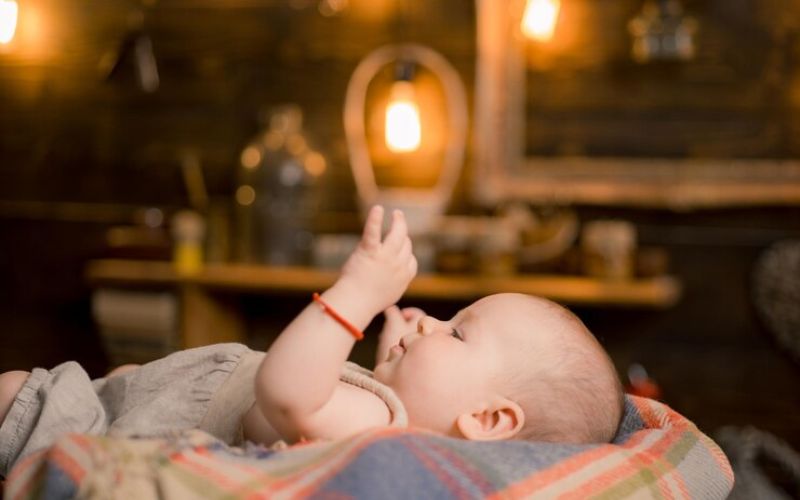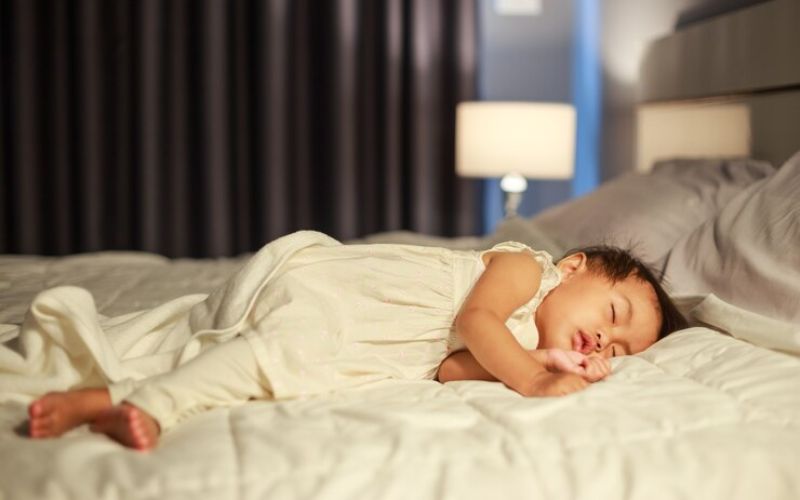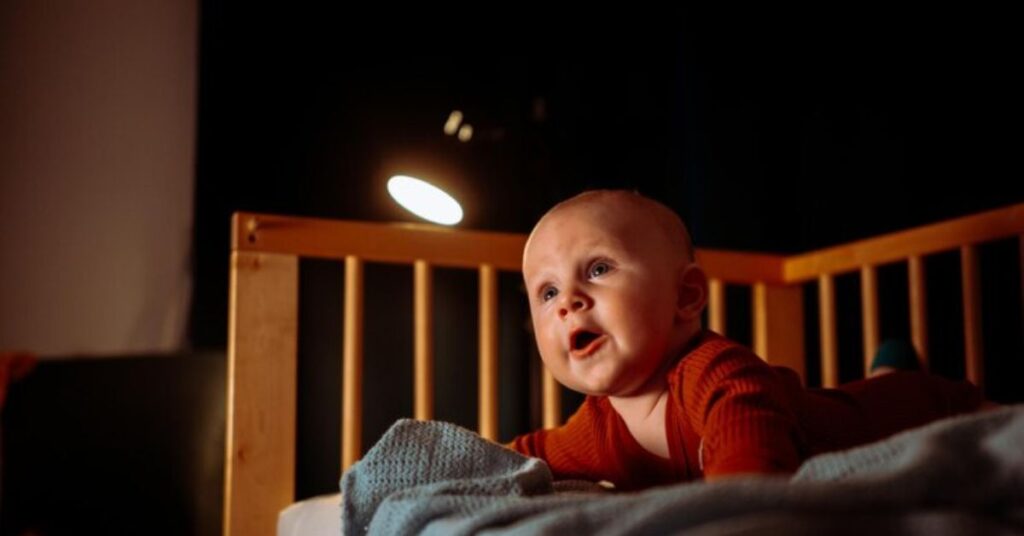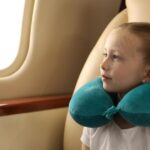Last Updated on October 26, 2023 by Muhammad Sohaib
As parents, we constantly strive to provide the best for our children. Understanding the effects of light on a baby’s eyes is crucial for creating a comfortable and safe sleep environment.
Night lights have become a common fixture in the nurseries and bedrooms of babies and young children. These soft, comforting glows are often used to soothe nighttime fears, making it easier for babies to sleep.
However, concerned parents may wonder if these night lights have any adverse effects on their baby’s delicate eyes.
In this article, we will explore the use of night lights and their potential impact on a baby’s eyes.
1. Understanding the Eyes of a Newborn
The eyes of a newborn 👶 are a marvel of nature. At birth, a baby’s visual system is far from being fully developed. Their eyes are highly sensitive, and they perceive the world differently from adults.
The development of a baby’s eyes
A newborn’s eyes are still developing after birth. They are rapidly growing and adapting to their new environment. This growth includes changes in the size and shape of the eye.
Sensitivity to light in the early stages
Newborns have sensitive eyes. They are more sensitive to light than adults, and this is primarily because the structures in their eyes, including the cornea and lens, are not yet fully mature.
2. Parental Concerns and Anxieties
Parents often grapple with worries and anxieties about their baby’s well-being, and the use of night lights is no exception.
Addressing worries about baby’s eyes
Parents may be concerned about whether night lights are harming their baby’s eyes. It’s essential to address these worries with information and guidance.
Seeking expert advice
If you’re uncertain about using night lights or their impact on your baby’s eyes, don’t hesitate to seek advice from pediatricians or ophthalmologists.
3. Night Lights and Their Purpose

Night lights serve various purposes for parents and babies alike. Understanding these purposes is the first step in determining whether they affect a baby’s eyes.
Why parents use night lights
Night lights are often used to provide a soft, dim light in a baby’s room during the night. This can be for the convenience of parents who need to check on their child without disturbing their sleep.
Different types of night lights

There are several types of night lights available, from traditional plug-in models to portable ones. Choosing the right one depends on the specific needs and preferences of parents.
When it comes to selecting the best night light for babies, it’s essential to consider factors like brightness, color options, and ease of use.
4. The Role of Light in Sleep
Light plays a significant role in regulating sleep patterns for both adults and babies. Understanding this role is essential in the context of night lights.
Circadian rhythms and sleep patterns
Circadian rhythms are the body’s internal clocks that regulate sleep and wake cycles. Light exposure, particularly natural light, influences these rhythms.
5. How light affects sleep quality

The quality of sleep can be significantly impacted by light exposure, as it can disrupt the body’s natural sleep-wake cycle. Understanding this impact is vital for parents who want to ensure their baby gets restful sleep.
6. Debunking Myths About Baby’s Eyes and Light
In the world of parenting, myths and misconceptions abound. Let’s address some common misunderstandings about how light affects a baby’s eyes and vision.
Common misconceptions
There are several myths related to this topic, such as the idea that exposing a baby to light too early can harm their eyes or that night lights can cause long-term vision problems.
7. Choosing the Right Night Light
If you decide to use a night light in your baby’s 👶 room, it’s crucial to make an informed choice.
Factors to consider when selecting a night light
Consider factors such as
- The brightness of the light
- the type of bulb
- And the design of the night light.
These factors can impact how it affects your baby’s eyes.
8. Effects of Excessive Light Exposure
While some light is necessary, excessive light exposure can have adverse effects on a baby’s eyes and overall well-being.
- Potential risks of too much light
Excessive light can disrupt your baby’s sleep and potentially harm their eyes. It’s essential to be aware of these risks and take measures to mitigate them.
- How it can affect a baby’s vision
Excessive light exposure can lead to discomfort and may impact a baby’s vision in the long term. It’s crucial to monitor and manage the light in your baby’s sleep environment.
9. Night Lights and Sleep Training
Night lights can be a valuable tool in sleep training for babies 👶, helping them adapt to a regular sleep schedule.
Using night lights in sleep training
Night lights can be strategically used to create a soothing and predictable sleep environment, which is essential for sleep training.
Tips for effective sleep training
Effective sleep training involves a combination of routines, including the use of night lights, to help your baby establish healthy sleep patterns.
10. Sleeping Patterns of Babies

Understanding the typical sleeping patterns of babies is crucial for parents who want to establish healthy sleep routines.
Typical sleep patterns in the first year
Babies go through distinct sleep patterns in their first year of life, which evolve as they grow.
Nighttime waking and soothing
Understanding how to soothe your baby during nighttime waking is essential for a peaceful night’s sleep.
11. Best Practices for Using Night Lights
To ensure the best experience for both parents and babies, certain practices should be followed when using night lights.
Creating a baby-friendly sleep environment
A baby-friendly sleep environment includes factors like temperature, bedding, and lighting that promote quality sleep.
Recommendations from pediatricians
Pediatricians often provide recommendations for creating a safe and comfortable sleep environment, including guidance on night light usage.
12. Night Light Alternatives and Sleep Solutions
If you’re not sold on the idea of using a traditional night light, there are alternative sleep solutions that can provide the desired comfort.
Natural light options for better sleep
Utilizing natural light sources, such as moonlight or soft natural lighting, can offer a soothing and gentle alternative.
White noise machines and other sleep aids
White noise machines and other sleep aids can create a calming sleep environment without relying on night lights.
13. Monitoring and Adjusting
As your baby grows, their needs and sensitivities change. It’s essential to monitor and adjust the sleep environment accordingly.
How to monitor the impact of night lights on your baby
Regular observation and understanding of your baby’s reactions to the night light can help you make necessary adjustments.
Adjusting the sleep environment as the baby grows
What works for a newborn may not be suitable for an older baby👶. Be prepared to make changes to the sleep environment as your child grows.
14. Safety Precautions with Night Lights
Safety is a top priority when using night lights in your baby’s room. There are specific precautions you should take to ensure a safe sleep environment.
- Avoiding hazards and accidents
Night lights should be installed and used with care to avoid accidents and hazards, such as tripping over cords or overheating.
- Childproofing the night light setup
If your baby is old enough to move around, take measures to childproof the night light setup to prevent them from tampering with it.
Conclusion
In conclusion, the use of night lights in a baby’s 👶 room is a matter of balance and careful consideration.
While there are concerns about their impact on a baby’s eyes, understanding the science, using safety precautions, and seeking expert advice can help parents make informed decisions.
A baby-friendly sleep environment, whether with or without a night light, can contribute to a peaceful night’s sleep and a happy, healthy baby👶.

Muhammad Sohaib is an experienced SEO expert with over 4 years in the digital marketing world. He is the founder of MomsChild.com, a growing parenting blog that covers topics related to kids, moms, baby products, and helpful family tips. Sohaib combines his SEO knowledge with a passion for creating content that supports parents in making informed choices. Through MomsChild, he shares practical advice, trusted product guides, and informative resources to help families navigate the joys and challenges of parenting in today’s world.







Very good article! We are linking to this great article on our site.
Keep up the great writing.
Thank you